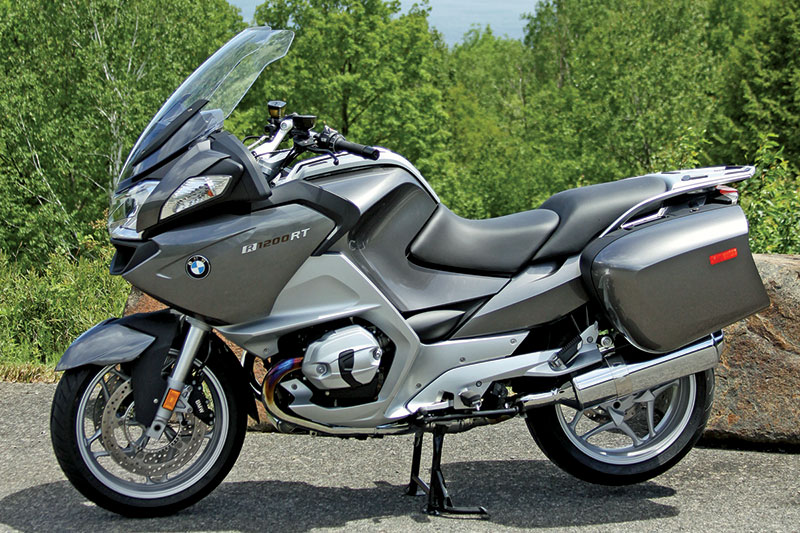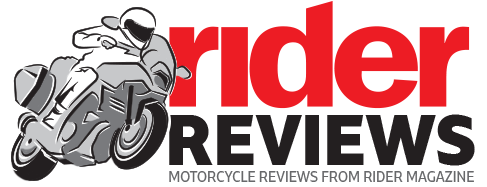2012 BMW R 1200 RT

Road Test Review
My, how time flies. Our last full test of a BMW R 1200 RT was back in August 2005, when you could still get money for nothin’ and mortgages for free. And an RT hasn’t ridden through the pages of Rider since July 2008, when we compared it to the Moto Guzzi Norge 1200—right about the time gas prices went through the roof and our economy came tumbling down.
Where has the RT been? Certainly not letting grass grow under its tires, that’s for sure. The R 1200 RT underwent a major update for 2010, including the same engine changes found on all Bavarian boxers: the HP2 Sport-derived radial four-valve, DOHC cylinder head, larger valves and throttle bodies, new pistons, a higher redline (8,500 rpm, up from 8,000) and a servo-controlled valve in the 2-into-1 exhaust. As we’ve reported in tests of the R 1200 R (October 2011) and R 1200 GS (August 2010), the result is a smoother-revving engine with a broader torque spread and friskier exhaust note. We weren’t able to dyno the 2012 RT, but Jett Tuning’s dynamometer recorded rear-wheel figures on the R 1200 R of 99.6 horsepower at 7,700 rpm and 76.2 lb-ft of torque at 6,300 rpm.
BMW didn’t host a 2010 press launch for the new RT, nor has it since, and RTs have been notably absent from BMW’s press fleet, with all bikes rolling off the assembly line going straight to dealers. BMW spent the last few years focused on its all-new S 1000 RR superbike and K 1600 GT/GTL sport/luxury tourers. Recently I visited BMW’s North American headquarters in Woodcliff Lake, New Jersey, to present Hans Blesse, newly appointed Vice President of BMW Motorrad USA, with Rider’s 2012 Motorcycle of the Year award for the K 1600 GTL. After handing over the crystal trophy, I sprinkled pixie dust around and walked out with the keys to a brand-new, well-appointed 2012 R 1200 RT in Fluid Grey Metallic!
With Rider’s Eastern Sales Manager Joe Salluzzo leading the way, we headed north, clutching our way through rush-hour traffic as New York City emptied out on a Friday afternoon, slowly but surely making our way to Springfield, Massachusetts. We had planned a couple days of scenic riding through Vermont and Upstate New York on our way to the Americade rally, in Lake George. Heavy rain and thunderstorms forced us to shorten our route, but the inclement weather and unseasonably cold temperatures provided the perfect opportunity to test the RT’s adjustable windscreen and optional heated grips and seat. They passed with flying colors, as did the user-friendly, watertight saddlebags and accessory top trunk, which can be locked and unlocked with the ignition key.
In addition to the engine upgrades, the 2010 R 1200 RT was the debut platform for BMW’s Multi-Controller, a thumbwheel between the left handgrip and switchgear that controls the optional audio system. (On the K 1600 GT/GTL, the Multi-Controller controls a whole lot more, from ESA II to navigation.) The RT’s styling and bike-to-rider interface were also updated. The side fairing panels were made smaller and sleeker, the front fender more aerodynamic. The windscreen was reshaped for less turbulence and coated to reduce glare, and its mounting points were braced to minimize vibration. And the RT’s integrated mirror housings were enlarged for more wind protection. Inside the cockpit, the instrument panel displays more information and reflects less sunlight, there’s a new quick adjustment knob for the headlight position, and the triple clamp and handlebars are new. The list of refinements goes on, from the larger clutch and brake fluid reservoirs to the enhanced air inlet for the oil cooler to the reshaped engine spoiler.
The optional Electronic Suspension Adjustment was upgraded from ESA I to ESA II, which adjusts spring rate in addition to damping rates and preload, and we’ve covered the details of ESA II in previous BMW road tests. The pushbutton convenience of setting suspension mode (Comfort, Normal, Sport) and load (rider, rider plus luggage, rider plus passenger) certainly makes life easier, but the $900 option adds weight and complexity. No one around here can remember the last time we rode an RT without ESA I or II, so how suspension performance differs from a standard RT remains an open question. Our ESA II-equipped test bike, however, was well-composed in a wide range of riding conditions, aided by the Telelever front end that separates suspension and steering, all but eliminating bump steer and fork dive during braking, though at the expense of some front-end feedback. The R 1200 RT has a balanced nimbleness shared with other R-bikes that results from years of refinement and the opposed boxer twin’s low center of gravity. It’s no wonder that the fleets of many Alps tour operators and municipal police departments are heavily stocked with the R 1200 RT.
Like a favorite pair of blue jeans, the RT is comfortable and unpretentious. It doesn’t warp time like the K 1600 GT or conquer the world like the R 1200 GS. Instead, it exemplifies the classic definition of “sport tourer,” balancing performance and excitement with practicality and reliability. The RT has been in BMW’s lineup since 1979, and it has benefited from methodical improvement over its 33-year history. Both rider and passenger enjoy neutral seating positions with supportive seats and generous legroom. There are large passenger grab handles, and the optional top trunk doubles as a comfortable back rest for your companion. In an effort to accommodate as many body types as possible, the rider portion of the standard seat can be raised from 32.3 to 33.1 inches, and a no-cost optional low seat can be set at 30.7 or 31.5 inches. Or you can buy a one-piece extra low seat (30.1 inches) and a lower suspension kit (29.5 inches with extra low seat). The reach to the handlebars and the distance between the grips felt very natural, allowing me to keep my back straight and my arms relaxed. Transitioning from laidback touring mode to apex-strafing attack mode required only minor adjustments: balls of feet on the pegs, windscreen in the lowest position and more lean. Cornering clearance was never a limitation.
With its wide, integrated mirrors and spacious cockpit, the R 1200 RT appears bulky from the saddle, a small price to pay for the generous wind protection it provides. Depending on whether it was raining lightly or apocalyptically, the sun was shining or it was cold and overcast, I fiddled with the adjustable windscreen constantly, always finding just the right amount of refreshing wind blast or reassuring coverage. Adjustments to the optional heated grips and seat (both with high/low/off settings) were done quickly with my right thumb, while my left thumb commanded the cruise control, windscreen, turn signal, audio system, ESA II, horn and info display. Everything made sense.
The R 1200 RT tested here was equipped with the RT Premium Equipment package, a $2,195 upgrade that includes the chrome exhaust, ESA II, heated seat and grips, cruise control, onboard computer (fuel consumption, tripmeters, etc.) and accessory socket, plus the $1,295 Audio/Communications Package that includes the Multi-Controller, audio system with tuner and Sirius XM satellite radio, Bluetooth, as well as interfaces for iPod and BMW Navigator IV GPS (sold separately). The locking compartment on the right side of the upper fairing includes a foam-padded pocket for an MP3 player, plus 3.5mm and USB ports (BMW adapter cable is an optional extra). Attach the accessory top trunk ($923, in White Aluminum only) to the standard luggage rack, and the as-tested price ramps up to $21,763, $4,413 more than the $17,350 base price. But for serious sport touring, that’s money well spent. In fact, I’d go a couple steps further and pony up for ASC (Anti Spin Control, $400) and the tire pressure monitor ($250).
But all that is just icing on the cake. What the R 1200 RT possesses, what it has always had but now has even more of, is a self-assured composure on the road. The counterbalanced 1,170cc boxer lopes along comfortably at low rpm, delivering tractor-like torque for climbing up tight, neck-straining switchbacks, but it also revs out strongly, delivering a potent blend of power, sound and feel, good for high-speed blasts whenever your heart and throttle hand desire. You’d be hard-pressed to find a more versatile engine, one that is as smooth without being dull. The RT has good throttle response, it clutches and shifts smoothly, and its single-sided Paralever swingarm eliminates shaft jacking and puts power to the ground with minimal driveline lash. And the RT’s front-to-rear-linked, triple-disc Brembo brakes with standard ABS are some of the best you’ll find among sport tourers, offering precise modulation and stop-on-a-dime power.
Prior to my week-long romp through New England, I hadn’t spent much time on the R 1200 RT, just a few hours here and there. But it proved to be the ideal two-wheeled companion. We became fast friends while exploring Vermont’s scenic Route 100, skirting along the edge of the Green Mountain National Forest and wandering down back roads in search of covered bridges. The RT’s Metzeler Roadtec Z8 tires hugged the road tightly and provided reassuring grip in the rain. Though fuel capacity has been reduced to 6.6 gallons from the previous 7.1, I averaged over 41 mpg (271 miles per tank) on the recommended midgrade. The optional audio system and cruise control worked well, but I found myself not using either very much, instead enjoying the quiet disconnectedness from the rest of the world and the natural cadence of blue highways.

